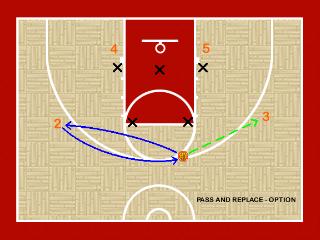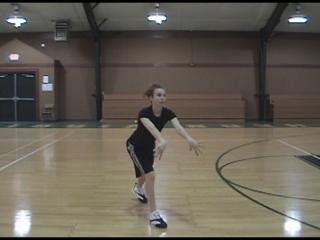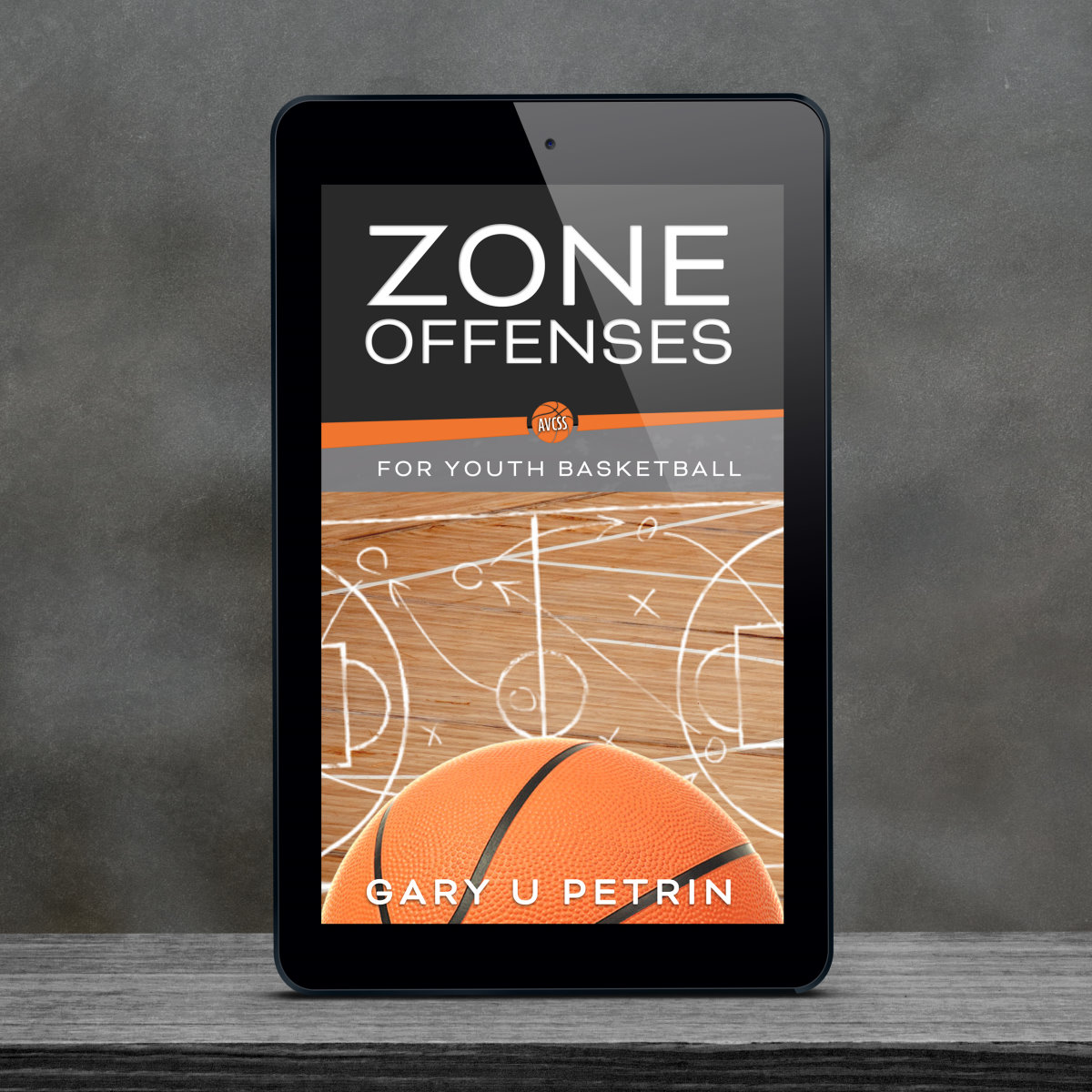Basketball Offenses for Youth – Zone Offenses
Youth Basketball Offenses (Zone Offenses) are the easiest of the offenses to teach younger basketball players. But, not necessarily the easiest offense to execute properly. Players can be easily taught the play, where to stand, but as you continue to read below, there’s a lot more to a zone offense than just standing around at a spot on the court. Zone defenses also happen to be the easiest defenses to teach the younger players. Having a good understanding of how to counteract against different zone defenses with the correct zone basketball offenses is essential.
Check out our new download publication “Zone Offenses for Youth Basketball”
General “Zone Offense” Tips / Notes
Analyze your opponents defense:

You must know what type of zone defense you are up against. Basically, you will either face a “1 guard” front or a “2 guard” front zone defense. You should have at least one zone offense for each of these types of defenses.
* Typical “1 guard” front defenses are 1-3-1, and 1-2-2 zone defenses.
Use a 2-guard zone offense to counter a 1-guard zone defense. Typical 2-guard zone offenses are 2-1-2, 4-corners, and the 4-out / 1 in offense.
* Typical “2 guard” front defenses are 2-3, 2-1-2, and 2-2-1 zone defenses.
Use a 1-guard zone offense to counter a 2-guard zone defense. Typical 1-guard zone offenses are 1-3-1, 1-2-2, 3-out / 2 in, or even a 1-4 type offense.
Attacking / Beating the Zone Defense:
Here are two ways to beat a zone defense.
The first and fastest way would be to “beat” the defense up the floor. This means run your fast break (transition offense) up the floor quickly before your opponent even has a chance to set up their zone defense.
The second way (which will take much longer) is to teach your players the “Teaching Principles of the Zone Offense” shown below – These are the main principles that coaches should teach their players. We have included a handout that you can download. It would be a good idea to make copies and hand them out to your players as needed.
Important Note: Coaches must make sure that they pay attention to teams that keep switching defenses. You must be prepared to counter by changing basketball offenses quickly. If you keep this in mind during the game, you will be ready for it when it occurs (and it might save you a time out or two?).

Teaching Principles of the Zone Offense
1. Dribble Penetration: Draw 2 defenders using the dribble by driving into the gaps of the zone. In other words, make 2 defenders guard one offensive player. This means that one of your teammates will be open! If the defense can guard 2 of our players at the same time, then we are not being active enough on offense and/or not using proper pacing. The Video Clip below refers to a Motion Offense, but the principle of driving relates also to Zone Offenses and all Basketball Offenses.
Good Opportunity to Drive on Offense
2. Play Behind The Zone: This adds another dimension to the offense you are running. A player that plays behind the defense can easily look for openings in the defense, get open for a shot, and go to the glass for the rebound. This minor technique will keep the defense busy and constantly looking back at players behind them. When a defense is not looking at the ball, you’ve got the edge!
3. Screen The Zone: First coaches need to teach players how to screen properly before they include screening in an offense. When screens are used properly in a zone offense it alters the defenders ability to move to their area of responsibility. Screening helps get good defenders off of your best shooter so they can get open for a good look at the basket. As a rule have the player that is setting a screen turn and look for the ball after a screen, they are usually wide open (A.K.A. Pick ‘n’ Roll).
4. Interfering With The Defense: When players are running their patterns and/or making cuts they should always try to “get in the way” of defenders anytime they can. This also adds in keeping the defenders out of their area of responsibility. In the example the offensive player is getting in the way of a couple of defenders while running their route. This player is doing one of the little things it takes to help the team. This is seldom taught in any of the Basketball Offenses.
5. Post Play: Main rule for post players versus a zone defense is to never post up on a spot on the floor, but rather to “seal” the defense and post up a defender. The player posting up on defender X1 is directly in front of the defender and ready to accept the ball (the defender is sealed off). The player posting up a spot on the floor instead of defender X2 is not in a position to accept the ball. In fact, if the offensive player passes the ball to this player, X2 will have a good chance of stepping in front of the pass and making a steal.
6. Pass Fakes: Pass Fakes are very effective ways to make a defense move out of sequence. When the defenders are reacting to pass fakes, this creates openings in the defense. Very essential to all Basketball Offenses.
7. Always Be Active: Don’t stand still, always be active. Players should move to gaps in the defense. Don’t make it easy for defenders to guard them. Make sure you are in a good position to receive a pass, help create a good passing lane. Movement with out the ball is very important. Players should try to turn defenders away from the ball. This is one of the essentials for any of the Basketball Offenses.
8. Patience: Make the defense work hard in any and all Basketball Offenses. Don’t rush the play unless you are behind, and need some points quickly. Coaches should tell players that the team is looking for the first available “open shot,” and that the player who is “open” should take the shot. Understand that not all open shots will go in, and for younger players shooting percentages may not be high. Coaches should help the players understand that even if the player misses the shot, as long as it was an open shot, there is no bad open shot.
9. Passing: Passing can make or break a teams Zone Offense. The main problem with the younger players is that they make soft passes to their teammates. Players must be taught that all passes must be thrown hard and have a little “zip” on them. Explain how a soft pass allows the defense the opportunity to steal the ball, which causes turnovers. When a player throws a soft pass and the defense steals the pass, it is called an “unforced turnover.” This means that the defense did not cause the turnover, and they didn’t have to work very hard for it either.

10. Offensive Rebounding: Consistently going to the glass (backboard), boxing out, and getting the offensive rebound is one of the most important elements to use against a zone defense. “Crash the boards” is a term widely used by coaches. Coaches should always take the time to explain a term to their players (especially the younger players). Players need to understand that an offensive rebound usually puts a player in position for an easy shot (since most offensive rebounds are under or closer to the basket. Without this aspect of the game, none of the Basketball Offenses work effectively.
As promised, here is the Handout on the Principles of the Zone Offense. Feel free to download, share…
Principles of a Zone Offense – Handout
A Simple Numbering System
Coaches will find it will be much easier to teach Basketball Offenses, especially a zone offense if they incorporate a simple numbering system (as shown below), this will help the younger players remember where to stand, and to understand the different positions, etc. The number system below is used frequently – but it doesn’t matter what numbering system you use – just use one…

Here are some notes regarding the numbering system, and the positions that are associated with each.

A Simple Zone Offense
Notes for Practicing Plays: The plays should be run from one side to the other, over and over until the players get comfortable with it. Add some defenders in the mix when you feel the players are ready – try to keep it “game like” as much as possible (I start with just a couple defenders, then work up to a full defense). The coach should dictate when the team should shoot while running the plays. Ex: Shoot after 6 passes, or just call a players name to shoot! Either way, it is important to keep running the play over and over until the players are comfortable with it.



This is really useful. My team won every game when we bought a book. Thank you very much.